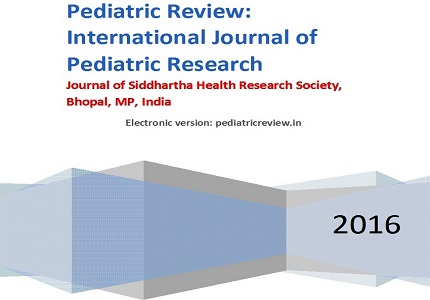Clinical profile of ascites in children at tertiary care hospital, North Karnataka
Abstract
Introduction: Ascites is a common clinical problem in children with liver and renal disease. The peripheral arterial vasodilation hypothesis is mostly accepted as the patho-physiological basis of ascites. The most important complication is spontaneous ascitic fluid infection in the form of spontaneous bacterial peritonitis (SBP) and its variants.
Objective: To know the incidence, etiology, associated clinical co-morbidities & the outcome (morbidity & mortality) of the hospitalized children with ascites.
Materials and Methods: After informed written consent from parents/ guardian, 102 children admitted with ascites irrespective of primary diagnosis were studied at department of Pediatrics, S. Nijalingappa Medical College, Bagalkot. The study was a prospective study and subjects were enrolled consecutively. Detailed history, complete physical examination & routine investigations were done in all patients and were recorded in predesigned proforma. A detailed etiological workup was done.
Results: The most common symptoms were abdominal distension (100%), facial puffiness (62.74%), pedal edema (46.08%), & generalized swelling (35.29 %). The most common signs were facial puffiness in 62.74%, pedal edema in 46.07% & anasarca in 35.29% the most common etiology of ascites was dengue fever, followed by nephrotic syndrome. Of the 102 children with ascites, 2 expired (Gaucher’s disease & Wilson’s disease).
Conclusion: Prompt and early diagnosis and appropriate management of ascites is warranted to prevent related morbidity and mortality in children.
Downloads
References
2. Hoefs JC, Jonas GM. Diagnostic paracentesis. Adv Int Med 1992; 37:391- 409. [PubMed]
3. Runyon BA. Care of patients with ascites. N Engl J Med 1994; 330:337-42. [PubMed]
4. Runyon BA. Ascites and spontaneous bacterial peritonitis. In Sleisenger MH, Fordtran JS, eds. Gastrointestinal diseases: pathophysiology, diagnosis, management, Vol II. Philadelphia: W.B. Saunders Company, 1993; 1977-2003.
5. Paddock FK. The diagnostic significance of serum fluid in disease. N Engl J Med 1940; 223: 1010-5. [PubMed]
6. Rovelstad RA, Bartholomew LA, Cain JC, et al. The value of examination of ascitic fluid and blood for lipids and for proteins by electrophoresis. Gastroenterology 1958; 34:436-50. [PubMed]
7. Light R, MacGregor M, Lucksinger P, Ball WC Jr. Pleural effusion: the diagnostic separation of transudates and exudates. Ann Intern Med 1972; 77:507-13. [PubMed]
8. Boyer TD, Kahn AM, Reynolds TB. Diagnostic value of ascetic fluid dehydrogenase, protein and white blood counts levels. Arch Intern med 1978; 138:1103-5. [PubMed]
9. Sampliner ME, Iber FL. High protein ascites in patients with uncomplicated hepatic cirrhosis. Am J Med Sci 1974; 267:275-9. [PubMed]
10. Seth V, Kabra SK. A clinical study of ascites in Children with special referance to Serum Ascitic Albumin Gradient. Essentials of Tuberculosis in children, 3rd edition; pg 143-53.
11. Runyon BA, Montano AA, Alkriviadis EA, Antillon MR, Irving MA, McHutchison JG The serum-ascites albumin gradient is superior to the exudate-transudate concept in the differential diagnosis of ascites. Ann. Intern. Med. 1992; 117:215 219. [PubMed]
12. Basu S, Ganguly S, Chandra PK, Basu S. Clinical profile and Outcome of abdominal tuberculosis in Indian children. Singapore Med J 2007; 48:900-5. [PubMed]
13. Aggrawal A, Chandra J, Aneja S, Patwari AK, Dutta AK. An Epidemic of Dengue Hemorrhagic Fever and Dengue Shock Syndrome in Children in Delhi. Indian pediatrics 1998; 35; 727-32. [PubMed]
14. Chopra K, BP Kalra, Indu S, Zeeba ZR: Clinico-pathological profile of children with Liver disease with Ascites. Curr Pediatric Research2008; 12 (1 & 2): 39 -41.
15. Nguyen KT, Sauerbrei EE, Nolan RL. The peritoneum and the diaphragm. In: Rumack CM, Wilson SR, Charboneau JW, editors. Diagnostic Ultrasound. St Louis: Mosby-Year Book; 1991.
16. Dinkel E, Lehnart R, Troger J, Peters H, Dittrich M. Sonographic evidence of intraperitoneal fluid. An experimental study and its clinical implications. Pediatr Radiol 1984; 14:299–303.
17. Thomas JR, Gunten CF. Diagnosis and management of Ascites; Principles & practice of palliative care & supportive oncology 3rd edition. Page no. 186-191.
18. Clark JH, Fitzgerald JF, Kleiman MB. Spontaneous bacterial peritonitis. J Pediatr 1984; 104:495–500. [PubMed]
19. Larcher VF, Manolaki N, Vegnente A, Vergani D, Mowat AP. Spontaneous bacterial peritonitis in children with chronic liver disease: clinical features and etiologic factors. J Pediatr 1985; 106:907–912.
20. Haghighat M, Dehghani SM, Alborzi A, Imanieh MH, Pourabbas B, Lalani M. Organisms causing spontaneous bacterial peritonitis in children with liver disease and ascites in southern Iran. World J Gastroenterol 2006; 12:5890–5892. [PubMed]

Copyright (c) 2016 Author (s). Published by Siddharth Health Research and Social Welfare Society

This work is licensed under a Creative Commons Attribution 4.0 International License.


 OAI - Open Archives Initiative
OAI - Open Archives Initiative


